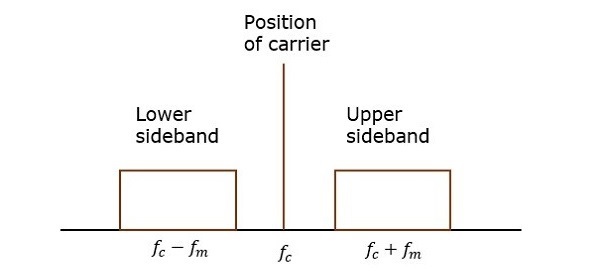


Double Sideband (DSB) modulation is a type of amplitude modulation (AM) technique where the message signal is modulated onto the carrier wave by multiplying it with a double-sided bandpass filter that contains both the upper and lower sidebands of the modulated signal. The resulting modulated signal contains both the upper
and lower sidebands and the carrier wave, which are transmitted through the communication channel to the receiver. At the receiver, the original message signal can be extracted by demodulating the received signal using a demodulator that recovers the message signal by filtering out one of the sidebands and the carrier wave.
Double Sideband (DSB) demodulation is the process of recovering the original message signal from a DSB modulated signal at the receiver. DSB demodulation involves multiplying the received signal with a local oscillator signal that has the same frequency as the carrier wave used in the transmitter,
which results in the production of an intermediate frequency (IF) signal. The IF signal is then passed through a bandpass filter that removes one of the sidebands and the carrier wave, leaving behind only the message signal. Finally, the message signal is amplified and output for further processing or playback.

DSB modulation involves multiplying the carrier signal with the message signal, which is a low-frequency analog signal, to produce the modulated signal. The resulting signal has two sidebands that are mirror images of each other and
a carrier frequency. The bandwidth of the DSB modulated signal is twice the bandwidth of the message signal.
Double-sideband suppressed-carrier transmission (DSB-SC) is transmission in which frequencies produced by amplitude modulation (AM) are symmetrically spaced above and below the carrier frequency and the
carrier level is reduced to the lowest practical level, ideally being completely suppressed.
DSB-SC is basically an amplitude modulation wave without the carrier, therefore reducing power waste, giving it a 50% efficiency. This is an increase compared to normal AM transmission (DSB) that has a maximum efficiency of 33.333%,
since 2/3 of the power is in the carrier which conveys no useful information and both sidebands containing identical copies of the same information. Single Side Band Suppressed Carrier (SSB-SC) is 100% efficient.
The figure in the right shows the Spectrum plot of a DSB-SC signal.
The expression for DSB-SC modulation is given by:
s(t) = Ac [m(t) cos(2πfc t)]
The expression for DSB-FC modulation is given by:
s(t) = [A + m(t)] cos(2πfc t)]
where Ac is the amplitude of the carrier signal, m(t) is the message signal, fc is the carrier frequency, and s(t) is the modulated signal.
The expression for DSB-SC demodulation is given by:
v(t) = m(t) cos(2πfc t)
The expression for DSB-FC modulation is given by:
v(t) = s(t) cos(2πfc t + φ)
where v(t) is the demodulated output signal, m(t) is the message signal, fc is the carrier frequency,s(t) is the received DSB modulated signal, φ is the phase difference.

DSB-SC is generated by a mixer. This consists of a message signal multiplied by a carrier signal. The mathematical representation of this process is shown below, where the product-to-sum trigonometric identity is used.
The figure (i) shows how DSB-SC generates: